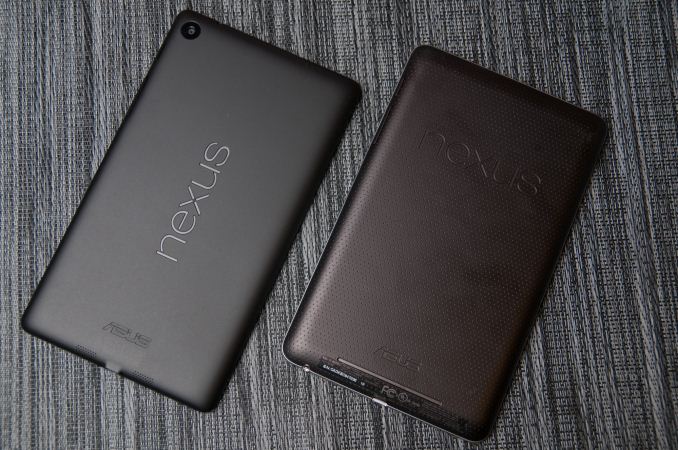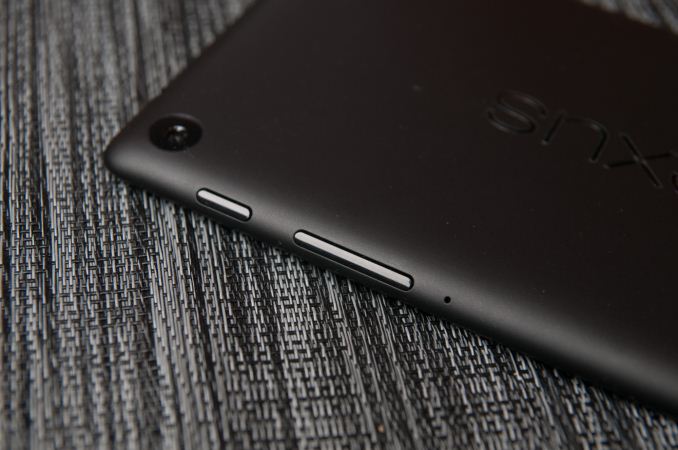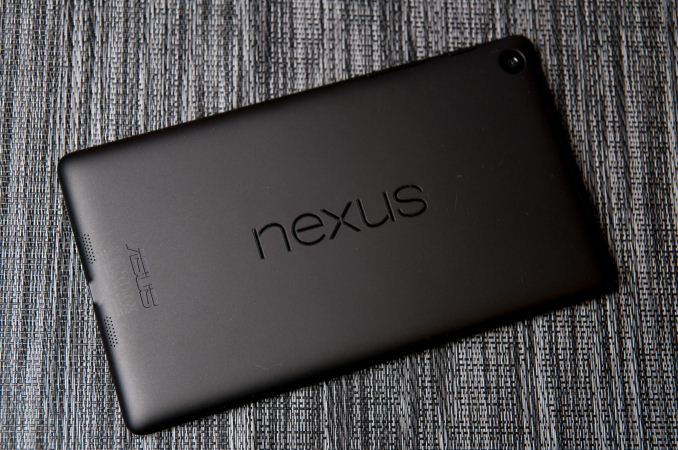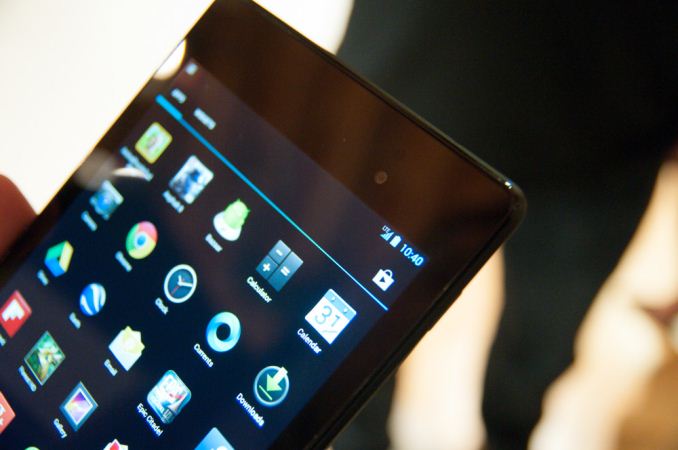Nexus 7 (2013) - Mini Review
by Brian Klug on July 27, 2013 12:54 AM EST- Posted in
- Tablets
- Snapdragon
- Qualcomm
- Android
- Mobile
- APQ8064
- Nexus 7
- Android 4.3

At an event in San Francisco, Google announced an updated version of the popular Nexus 7 tablet which first appeared at last year’s Google I/O. The big new features update the Nexus 7 platform with inclusion of a 1.5 GHz Snapdragon S4 Pro (APQ8064) SoC, 1920x1200 display by JDI (Japan Display Inc), as well as 5 MP rear facing camera, 1.2 MP front facing camera, stereo speakers, dual band WiFI, wireless charging (Qi) and a thinner and lighter chassis. It’s a major update that keeps the competitive price point that made the original Nexus 7 appealing (the lineup starts at $229 for the 16 GB model) while bringing numerous much-needed improvements that people have asked for.
First off, it’s shocking how much of a difference the change in thickness and weight makes. The new Nexus 7 feels considerably lighter and thinner in the hand than its older counterpart. Gone is the textured rubberized (almost driver glove-like) material on the back, in its place a flat, uniform soft touch material. There’s Nexus emblazoned in landscape on the rear, which is a bit puzzling next to the 90 degree rotated ASUS down below. It irritates my OCD sensibilities seeing the two logos inexplicably perpendicular and right next to each other, but I suppose Google thinks this helps emphasize how much the Nexus 7 and Android platform are really tablet-friendly now, with landscape view support throughout the core apps.
The rear facing camera is in the extreme top left, next to the power and volume rocker buttons, and top speaker. The Nexus 7 build and finish does feel a bit more plasticky to me this time around, but that’s almost expected given the price point, and it isn’t a major dig on the hardware at all. That’s not to say it isn’t sturdy or well put together, but just that the original Nexus 7 left a stronger impression on me last time, and I’ve been spoiled by the ASUS FonePad since then. The edge chamfer also helps the Nexus 7 feel a bit more like the Nexus 4 with its rounded edge. The previous Nexus 7 came to a point that could be a bit sharp at times.
What’s a little awkward is how tall the bezel at top and bottom looks on the Nexus 7, I’m warming up to it. On paper the new Nexus 7 is smaller in almost every dimension, in reality the elongated aspect ratio is definitely a bit pronounced here. There’s also still a notification LED well hidden under the glass at bottom in the center.
On the back is the new 5 MP rear facing camera, buttons (which hug the edges), a microphone port, and speakers. The speakers fire out the back of the Nexus 7 and look like they have good separation (obviously the best that the device’s size affords – top and bottom), but I don’t have a good feel for just how loud they go quite yet. Having stereo is a dramatic improvement for the audio part of video and multimedia consumption, and Android does 5.1 virtualization out the speakers as well. On the connectivity side of things there’s microUSB at the bottom with SlimPort video out, and a 3.5mm audio jack. I know a lot of people were hoping for inclusion of line in on the 3.5mm audio jack but I can confirm it isn’t present.
| Nexus 7Tablet Specification Comparison | ||||
| ASUS Nexus 7 (2012) | ASUS Nexus 7 (2013) | |||
| Dimensions | 198.5 x 120 x 10.45mm | 200 x 114 x 8.65mm | ||
| Chassis | Plastic + Rubber back | Plastic + Soft Touch back | ||
| Display | 7-inch 1280x800 IPS | 7.02-inch 1920x1200 IPS | ||
| Weight | 340 g | 290 grams (WiFi), 299 grams (LTE) | ||
| Processor | 1.3 GHz NVIDIA Tegra 3 (T30L - 4 x Cortex A9) | 1.5 GHz Qualcomm Snapdragon S4 Pro (APQ8064) | ||
| Memory | 1 GB | 2 GB DDR3L | ||
| Storage | 8 GB / 16 GB | 16 GB / 32 GB | ||
| Battery | 16 Whr | 15.01 Whr | ||
| WiFi/Connectivity | 802.11b/g/n, BT, NFC | 802.11a/b/g/n, BT 4.0, NFC | ||
| Camera | – |
5.0 MP Rear Facing w/AF 1.2MP Front Facing |
||
| Wireless Charging | – | Yes (Qi Compatible) | ||
| Pricing | $199/$249 |
$229/$269 (WiFi 16/32 GB) $349 (LTE) |
||
My only real complaint with the new Nexus 7’s in hand feel and build is with the power button and volume rocker, which feel somewhat mushy to me. I had issues taking screenshots even at times. It’s a minor gripe, but with only three buttons on the whole device, and generally good execution by ASUS with buttons on tablets, it surprised me. I guess I also do miss that racing glove-inspired texture in the soft touch on the back of the original Nexus 7.
| Nexus 7 (LTE) Band Coverage | |||||
| Model | GSM/EDGE Bands |
WCDMA Bands (HSPA+ 42) |
LTE Bands (UE Category 3) |
||
| North America Nexus 7 LTE |
Quad Band (850 / 900 / 1800 / 1900 MHz) |
HSPA+: 850/900/1900/2100/AWS(1700/2100) MHz (Bands: 1/2/4/5/8) | 700/750/850/1700/1900/2100 MHz (Bands: 1/2/4/5/13/17) | ||
| Europe Nexus 7 LTE | 800/850/1700/1800/1900/2100/2600 MHz (Bands: 1/2/3/4/5/7/20) | ||||
There’s a version of the Nexus 7 with 32 GB of storage and LTE onboard for $349 which will appear ‘in the coming weeks’ and includes support for AT&T, T-Mobile, and Verizon LTE in the USA on one piece of hardware. This is the first single SKU solution I’m aware of with coexistence of Bands 13 and 17 (Verizon and AT&T respectively) on the same device, which is awesome. There’s a model with Bands 3, 7, and 20 for Europe as well, so they’re not left out of the LTE fray. I had a chance to quickly get a look at the new Nexus 7 with LTE, which includes a microSIM tray and was working on one of the LTE networks in San Francisco just fine.
As far as I know, the Nexus 7 LTE solution is Qualcomm’s MDM9215 with a WTR1605L transceiver inside, and doesn’t necessarily include any of the new RF360 brand of front end hardware (like the power amplifier with integrated antenna switch or tunable front end), since MDM9x15 only works with QFE1320 (Bands 1,2,3/4,5,8,20). Still, that makes it all the more impressive, and Google deserves considerable kudos for further pushing such unprecedented interoperability, since in a tablet you do have more area to include discrete power amplifiers and filters.




















252 Comments
View All Comments
phillyry - Tuesday, July 30, 2013 - link
Anand also mentioned that it's possible for the different capacities to have different eMMC controllers.However, they didn't last year.
Would be good to know for this year's models.
Broo2 - Saturday, July 27, 2013 - link
There should not be a difference and the 16GB/32GB flash is used only for storage.phillyry - Tuesday, July 30, 2013 - link
Did you read the article?Brian addressed the real lagging issues that Nexus 7 gen. 1 users have been having. He stated that it was likely caused by the storage I/O and that it should be fixed via software.
Point is, storage is usually the performance bottleneck of a system.
et20 - Saturday, July 27, 2013 - link
Thanks for the review.I really appreciate it much more than your standard review format.
I only read those if I'm 90% sure I want to buy the product because they are too long.
phillyry - Tuesday, July 30, 2013 - link
+1Ya, we should have this short, sweet, and immediate reviews initially for all major products.
TareX - Saturday, July 27, 2013 - link
I enjoyed having an Nexus 7 (till it became unbearably buggy, slow, and eventually broke with no trauma)... but I must say, walking around with two Androids is extremely cumbersome. Having apps and files scattered between two devices is annoying... This lead me to the conclusion that I need to invest in a phablet. It comes with the added advantage of excellent battery life on your one and only Android. That said, a viable alternative would be an affordable version of ASUS' Padphone product. But their screen dock is ridiculously overpriced, I can only see a +5.5" phablet as my only choice here. I hope the HTC One Max comes with a split-screen functionality so I wouldn't have to go for the Note III.torp - Saturday, July 27, 2013 - link
How about comparing wifi signal between the nexus 7 old and nexus 7 new? There are spots in my home where the old nexus 7 simply doesn't work, and it's not a big home.Brian Klug - Saturday, July 27, 2013 - link
Good question, I was never a huge fan of the Azurewave WLAN combo inside the original Nexus 7, I believe WCN3660 and its front end might be better. I would need to compare FCC disclosures and do some testing to find out, unfortunately most mobile devices are pretty constrained, and perform around the same (outliers being those with poor enclosure designs).-Brian
torp - Sunday, July 28, 2013 - link
Oh forgot an important data point: i also have an iPad 1 and that one has no problems with wifi anywhere in my home... so basically I could say the nexus 7 old's wifi was a bit crap :)zepi - Saturday, July 27, 2013 - link
When you do a battery life test, could you run one test at much higher brightness level than the standard? On my 3rd Gen iPad I've noticed that the device really struggles with max brightness setting that is more or less required when using the device outside in sunshine.Unlike often far too hefty laptops, people actually carry their tablets around want to use them things on their patios, balconies and outdoor cafeterias.
Otoh, it's not just the peak brightness, but overall visibility and readability of the screen that'd need to be normalised for such testing. Contrast ratios of screens can vary greatly under plentiful exposure to external light, as manufacturers employ different coatings and "clearblack" technologies, not to mention oled vs tft etc.